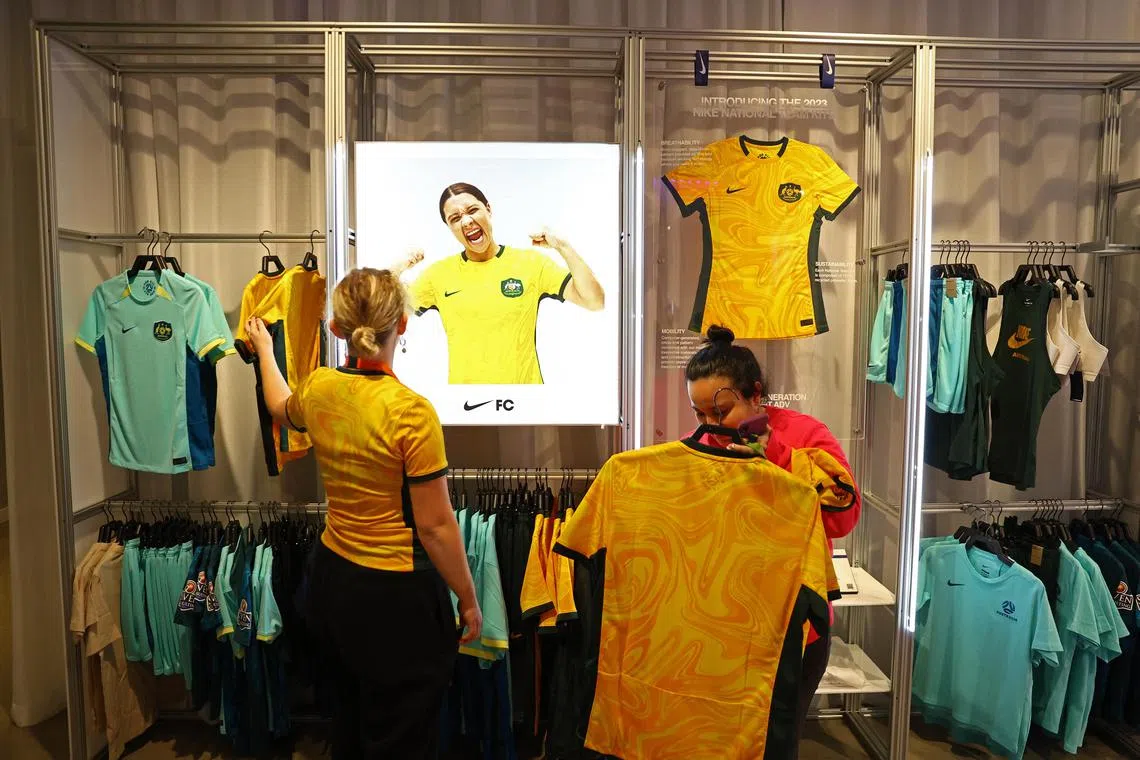As the Women’s World Cup breaks records, Adidas, Nike navigate bumps in retail demand
Sign up now: Get the biggest sports news in your inbox

A poster of Australia forward Sam Kerr in the Nike FC shop in Sydney on Aug 14.
PHOTO: REUTERS
Follow topic:
AUCKLAND – The unpredictability of the Women’s World Cup, with the United States knocked out early
The tournament in Australia and New Zealand promises to be among the most popular standalone women’s sporting events, with Fifa expecting viewing figures of some two billion, despite time zone differences that make it difficult for many Europeans and Americans to tune in.
Adidas and Nike and retailers like Dick’s Sporting Goods and Fanatics have made significant investments in merchandise. Total sponsorship value grew to at least US$349 million (S$473 million), from US$342 million in 2019, according to GlobalData, with many brands aligning themselves with themes of women’s empowerment.
At Dick’s, where 76 clothing and products tied to the US Women’s national team were available online on Monday, more than two-thirds are discounted by 25 per cent to 35 per cent, including jerseys, T-shirts and hoodies, according to a check of its website.
Nike’s marketing ahead of the Women’s World Cup featured a football fan telling her father that “the competition is better than ever”, with cameos from a roster of past and current stars, including US players Megan Rapinoe and Alex Morgan, French player Grace Geyoro and Nigerian forward Asisat Oshoala.
Overall for Nike, which sponsors the US, England and other teams, only eight per cent of women’s team products have sold out thus far during the tournament, according to data collected by Centric Pricing and Refinitiv.
That is down from 13 per cent of Nike’s women’s team products which sold out during the same tournament in 2019, the data shows.
At Adidas, which sponsors Sweden and Spain – the teams that met in Tuesday’s semi-final
Adidas doubled its production of Germany women’s jerseys for this World Cup, compared to the 2019 tournament, and was still on the verge of selling out when the team fell out of the running early.
“That tells you something about the exponential growth of the sport,” said Adidas spokesman Jan Runau.
One in three fans of women’s football are new to the sport, according to Yvonne Henderson, chief executive officer of UK-based industry association Women In Football.
“The fan base is unique, it’s diverse, it’s quite youthful and it has strong progressive values,” she said.
For that reason, marketers must bear in mind the risk that the growing fanbase could see their support for football’s as disingenuous. “Their message has to come off as sincere, and must be backed by action and long-term commitment as opposed to just 30 seconds of bluster that ends when the event is over,” said Bob Dorfman, creative director at Pinnacle Advertising.
Nike, sponsor of England, faced criticism from goalkeeper Mary Earps for not producing a replica goalkeeper jersey.
Adidas, which does not produce women’s goalkeeper jerseys for the teams it sponsors either, said that was a mistake.
French telecom company Orange’s World Cup advertisement seeks to directly challenge the notion that women’s football is less skilful or exciting
Sporting goods retailer Fanatics has more than 475 US women’s team products for sale this year, up from about 175 in 2019, the company told Reuters.
Overall, in the month leading up to the start of this year’s tournament, sales of women’s football products on Fanatics were up more than 80 per cent compared to the last Women’s World Cup in 2019. REUTERS

